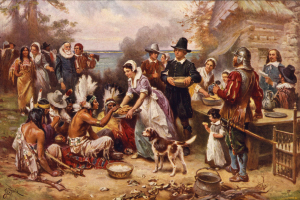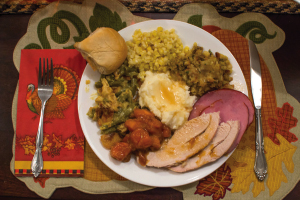
Now a traditional holiday in American life, the first Thanksgiving was a simple celebration of the Pilgrims’ first corn harvest and an expression of gratitude
to the Indians, who had taught them how to plant and fertilize their crop.
Photo from Encyclopedia of Discovery and Exploration: Rivers of Destiny.
A LITTLE PIECE OF HISTORY | By Joan Frances –
The gathering of family and friends during Thanksgiving is one of the most memorable times of the year. Thanksgiving is a secular holiday that is celebrated nationally by almost every culture and religion. People prepare food in advance and recite invocations giving thanks for a bountiful meal. The early settlers of Fort Bend County learned how to sustain life in difficult times – from severe weather and drought to government conflicts and war. When the time came to give thanks, a celebratory holiday took place, and everyone united to share in the wealth of the land.
The Thanksgiving tradition originated in New England with the small ship called the Mayflower, which carried 102 passengers from England. They traveled for 66 treacherous days to the New World in search of religious freedom and the promise of prosperity and land ownership. During the first brutal winter at Plymouth, only half of the original passengers lived, most of them staying on board the ship.
Then in the spring, the remaining settlers moved ashore and were greeted by an English speaking Native American of the Abenaki tribe named Samoset. Several days later, he brought Squanto, a Native American and member of the Pawtuxet tribe, to meet the Pilgrims. Squanto taught the Pilgrims, who were ill and weakened by malnutrition, how to plant corn, catch fish from the rivers, stalk and trap wild game and extract sap from maple trees.
Squanto was also instrumental in forging an alliance with the Wampanoag tribe, which endured for 50 years. In 1621, the Plymouth colonists and these Indians celebrated together with an autumn harvest feast to thank God and each other for the gift of giving and receiving. In 1789, President George Washington proclaimed the first national observance of Thanksgiving. President Abraham Lincoln initiated the tradition of Thanksgiving as a national annual day in 1863, more than 200 years after the first Thanksgiving.
 On March 2, 1842, Sam Houston declared Texas Independence Day to be a day of celebration of freedom and thanksgiving. In 1849, Governor George Wood proclaimed the first Texas observance of Thanksgiving to be the first Thursday in December. The festivity was a multicultural event after harvest. The residents of the area participated in this decreed holiday and traveled by horseback, wagon, boat and foot to congregate in the main square of Richmond and Rosenberg in celebration of Thanksgiving. This was usually a three-day festival filled with sharing successful harvest and baked goods, singing songs, dancing to music by local musicians and playing games. Ranchers and farmers took this time to trade livestock and harvests in anticipation of the winter months. Turkey was not on the menu. Instead, ducks, geese, chicken, deer and beef were the main meat source. Corn was plentiful, as well as other vegetables, fruits and nuts.
On March 2, 1842, Sam Houston declared Texas Independence Day to be a day of celebration of freedom and thanksgiving. In 1849, Governor George Wood proclaimed the first Texas observance of Thanksgiving to be the first Thursday in December. The festivity was a multicultural event after harvest. The residents of the area participated in this decreed holiday and traveled by horseback, wagon, boat and foot to congregate in the main square of Richmond and Rosenberg in celebration of Thanksgiving. This was usually a three-day festival filled with sharing successful harvest and baked goods, singing songs, dancing to music by local musicians and playing games. Ranchers and farmers took this time to trade livestock and harvests in anticipation of the winter months. Turkey was not on the menu. Instead, ducks, geese, chicken, deer and beef were the main meat source. Corn was plentiful, as well as other vegetables, fruits and nuts.
Thanksgiving Day celebrations became highly anticipated for residents to share their successes, trade and develop friendships. City leaders also took the opportunity to campaign for re-election and lobby for new laws. Native Americans from the Karankawa tribe inhabited the area in Fort Bend County and lived around the Brazos and its river bottom. They were not a threat to the colonists, and they moved out of the area toward Mexico by the 1850s.
As Fort Bend County grew, Thanksgiving evolved to include a greater population of diversified people. The message was always the same: Live in harmony, give thanks and respect all cultures, religions and nationalities.